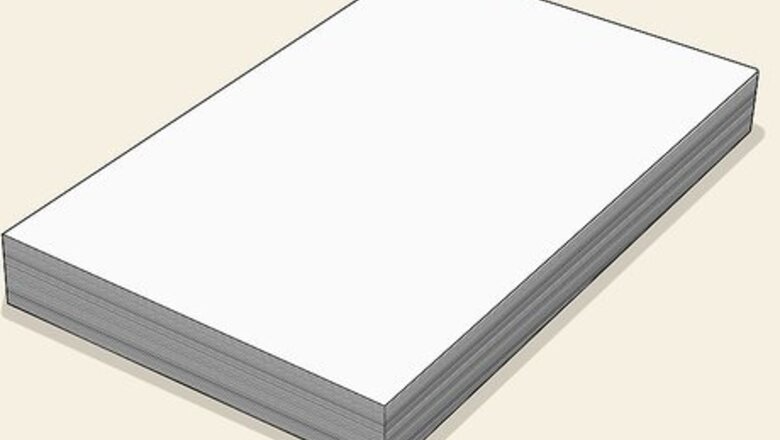
views
Taking Measurements with a Ruler

Stack a bunch of papers together in a neat pile. If you’re able to, use a freshly-unwrapped stack of papers. Since they are all the same size, you will be able to get a more accurate measurement. If you don’t already have a stack, choose papers that appear to be roughly the same size. Stack them on top of a flat surface, such as a table. You can still take the measurement if your stack has different types of paper mixed in, but the result won’t be as accurate as it normally would. Each sheet could be a different thickness. If you have to measure a specific, single sheet of paper, use a digital caliper instead for the most accurate result.
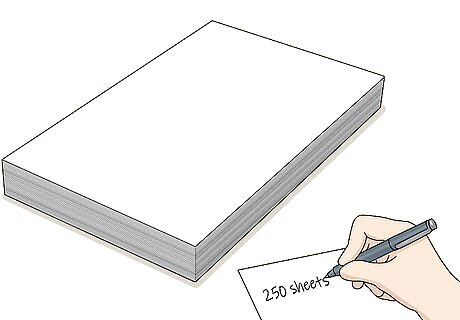
Count the number of papers in the stack. If you’re using fresh paper, check the wrapping. Manufacturers typically list the number of sheets there. Otherwise, count each paper individually and write the number down for later. Check the manufacturer’s count carefully. Sometimes they count double-sided sheets twice. If that happens, divide the total count by 2 to get the actual number of papers in the stack. For example, 500 double-sided pages / 2 = 250 sheets.
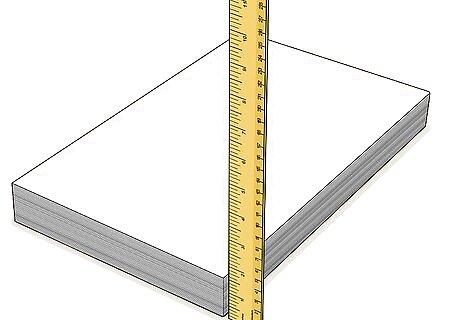
Measure the thickness of the entire stack with a ruler. Set a ruler against the edge of the stack. Press it down firmly against the table. Then, take the measurement and record it. The measurement should be the same on all sides of the stack, so it doesn’t matter which one you choose. For uneven stacks, such as newspaper, consider placing something heavy on top of it to keep it pinned down. Otherwise, you might have a hard time getting a precise reading.
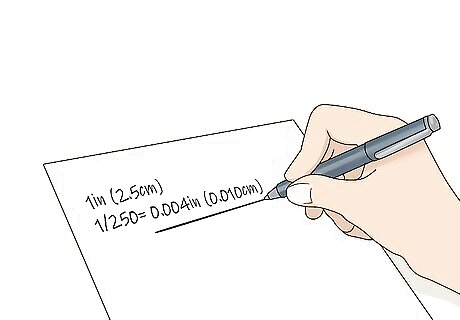
Divide the thickness by the number of pages. With a calculator, you can determine the thickness of a single sheet of paper. Convert any measurements taken as fractions into decimal numbers. After finding out the thickness, double-check your calculations to ensure you’re dividing the numbers in the correct order. The result should be a very small number since individual sheets of paper are very thin. For example, if you have a 1 in (2.5 cm)-thick stack consisting of 250 sheets of paper: 1 / 250 = 0.004 in (0.010 cm). If you took a measurement as a fraction, such as ⁄4 in (0.64 cm), convert it first. For instance, 1 / 4 = 0.25 in (0.64 cm).
Using a Digital Caliper
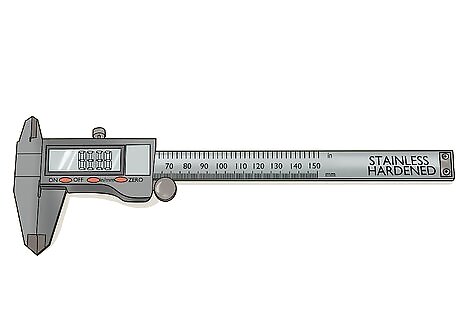
Purchase a digital caliper for a simple way to measure thickness. There are several different types of calipers, but digital ones are by far the easiest to use. Once you put the paper in the tool, it automatically displays the thickness. Digital calipers can also display measurements in both inches and millimeters. With manual calipers, you have to read the meter on them to determine the thickness. Calipers are available online and at most hardware stores. Manual calipers are more common and inexpensive than digital ones. All types of manual calipers work similarly. Vernier calipers are the most common type and have a sliding scale used to measure thickness. Dial calipers have a spinning dial instead.

Close the tool’s jaws and reset it to 0. A caliper looks like a ruler with a clamp on one end. If you’re using a digital model, it will also have a display situated on the ruler portion. Look for a metal wheel attached to the bottom edge of the scale. Rotate the wheel to close the calipers completely, then press the zero button on the display to reset it. Always reset digital calipers before taking a measurement. If you don’t do this, you could get an inaccurate result.
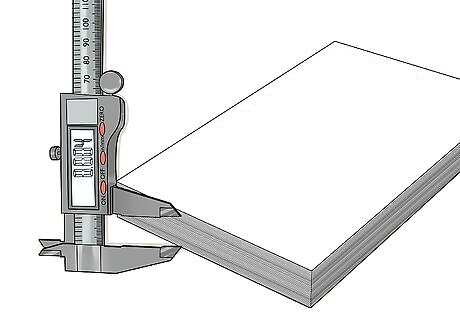
Open the jaws and put the paper between them. Use the wheel to open up the jaws enough to insert the paper. After sticking the paper in, close the jaws again to pin it in place. Make sure the jaws close enough to hold the paper still. A digital caliper can work with only a single sheet of paper. For an accurate measurement, the jaws should clamp down tightly on the paper. However, take care not to crush or bend the paper, since that could throw off the measurement. You could potentially measure a stack of papers, then do some additional math to figure out the thickness of one sheet. Try it if you’re having trouble getting the caliper to work
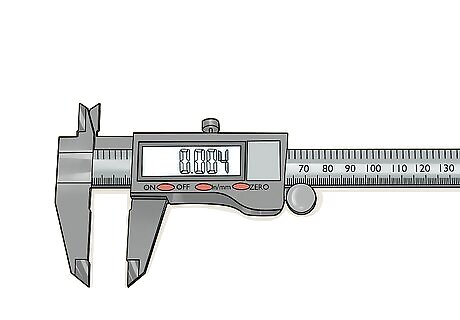
Read the measurement on the display to determine the thickness. The display should light up right away. It automatically measures the thickness according to how far the tool’s jaws are open. Adjust the jaws as needed to ensure you get the most accurate measurement possible. If you measured a stack of paper, divide the thickness by the number of sheets you used. For example, a 1 in stack / 250 sheets = 0.004 in-thick sheets of paper.
Operating a Manual Micrometer or Caliper
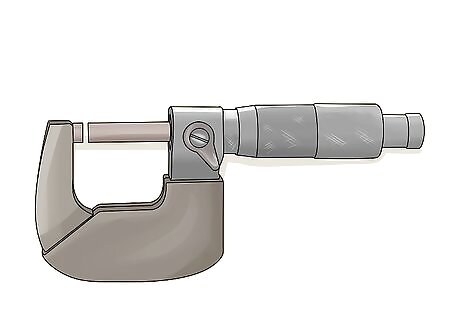
Choose a micrometer if you wish to get a more accurate measurement. Both micrometers and manual calipers work the same way. However, micrometers are designed to capture smaller measurements. They include an additional scale that offers additional precision. Since the average sheet of paper is so thin, you should consider using a micrometer for maximum accuracy. If you don’t need absolute precision, Vernier or dial calipers are still a good choice. They require slightly less effort to read. Note the unit of measurement used for the tool. Some tools use inches. Metric tools use millimeters.
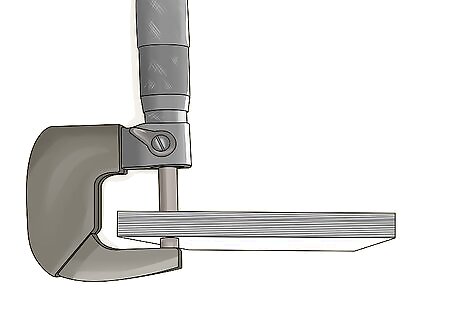
Open the tool, then insert the paper between its jaws. Operate a micrometer by spinning the handle, also called a thimble. The thimble is opposite from the jaws, or spindle, and will have small numbers printed on it. Turn the thimble counterclockwise to open it. After sticking the paper in, close the spindle to pin the paper in place. Make sure the paper is secure to the tool. Since single sheets are so thin and flexible, determining the thickness is easier if you use a stack of papers instead. If you’re using a caliper, look for a small wheel attached to the lower end. Turn it counterclockwise to open the tool’s jaws.
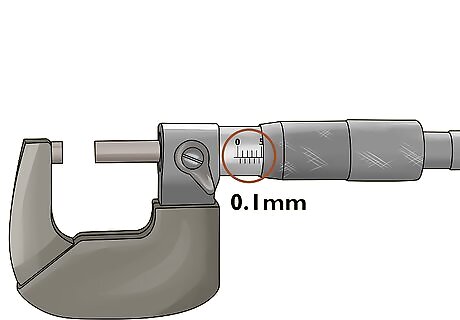
Read the number on the micrometer shaft first. The first scale is on the sleeve of the micrometer, which is the part right in front of the thimble. It is easy to recognize because of the large numbers printed on it. This scale is basically a ruler. To determine the first digit in the measurement, check where the thimble rests on the scale. The numbers on the scale correspond to tenths of an inch, or millimeters if you’re using a metric version. If you’re measuring a small stack of papers, the front edge of the thimble may be at the line marked 1. The measurement, then, is 0.1 in. For Vernier calipers, look at where the 0 on the lower scale lines up with the lines on the upper scale. Count over from 0 on the upper scale to take the measurement.
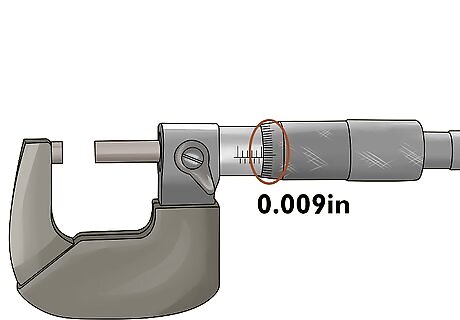
Note the lines on the edge of the thimble for the next measurement. Check the lines that are perpendicular to the spindle. These lines will be numbered from 0 to 25. Look to see which line is closest to the one in the ruler scale you used earlier. Note this measurement down on paper. For example, the scale may align with the 9 marking. It corresponds to 0.009 in. Add this number to your last measurement. If the lines don’t match up perfectly, choose the lower number on the thimble. For example, if the scale line falls between 10 and 11, use 10, or 0.010 in. Note that calipers don’t have this scale. If you’re using calipers, skip this measurement.
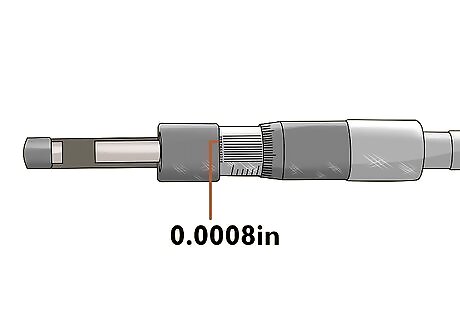
Check the gauge on the sleeve to complete the measurement. Rotate the tool to spot thin lines running from the spindle to the thimble. These lines are marked 1 through 11 and represent the final digit in the measurement. One of these lines will match perfectly with the marks on the thimble. Note the number listed nearby, then tack it on to the end of your measurement. For example, you may notice that the line marked 7 matches up perfectly with the thimble. It corresponds to 0.0008 in. This scale is called a Vernier scale. It works the same way for manual calipers. On a manual caliper, it is the small scale on the sliding jaw.

Add up the measurements to get the total thickness of the paper. Jot down all of the measurements on paper if you haven’t already. Make sure they are neat and accurate. Many people, when they’re first using these tools, forget some of the 0s in the decimals. If you leave off a digit, you won’t get an accurate result. For instance, 0.1 + 0.009 + 0.0008 = 0.1098 in thick. If you measured a stack of paper, divide the thickness by the number of sheets in the stack. For example, 1 in stack / 250 sheets = 0.004 in-thick sheets of paper.




















Comments
0 comment